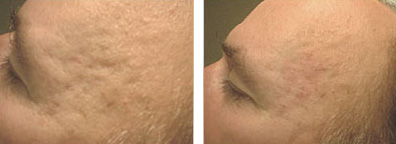ACNE SCARRING


Acne is a skin condition that occurs when the hair follicles become plugged with sebum and dead skin cells. The body naturally releases sebum through the hair follicles in order to lubricate the skin and hair. The body also rids itself of dead skin cells through the hair follicles. When too much sebum and dead skin cells are being released, they can clump together and form a plug in the hair follicle, causing acne. Acne comes in two forms: non-inflammatory lesions and inflammatory lesions.
Non-inflammatory lesions come in the form of whiteheads and blackheads. Whiteheads appear flesh-toned and bumpy and have not been exposed to the air. Blackheads appear black and bumpy and have been exposed to the air through a small opening in the skin. Inflammatory lesions come in the form of pustules, nodules and cysts. Pustules are red, raised and tender. They are the first sign of infection in the skin. Pustules, also known as pimples, are red, raised, tender and have a white center filled with puss. Nodules are large, solid, painful lumps beneath the skin’s surface. Cysts are swollen, painful, puss-filled lumps that form deep beneath the skin’s surface.
Acne can occur on the face, neck, chest and back. Acne can occur for a number of reasons. Common causes are the changes in hormone levels that occur during puberty, birth control intake, and pregnancy. Other causes are certain medications such as corticosteroids and lithium. Most acne subsides by the age of twenty-five, however some individuals may struggle with acne in their twenties, thirties, forties and beyond. While most acne symptoms can be treated with over-the-counter drugs, severe forms of acne can be seemingly resistant to these forms of treatment. For these tough cases of acne, Dr. Paul Jarrod Frank can prescribe more potent medications such as Isotretinoin.
Whether an individual’s acne has been mild, moderate or severe, evidence is usually left in the form of scars. Acne scarring occurs as a response to damage in the skin’s epidermis and dermis. The dermis is made up of collagen and elastin that connect in a mesh-like pattern. When damage occurs, the body’s response is to repair the damage. Fibroblasts are cells that repair the damage and produce new collagen and elastin. However, the new collagen and elastin that forms do not assume the same form that existed before. This results in inconsistencies in the skin’s texture and tone.
Watch Dr. Frank discuss the various treatments for Acne Scars
Just like a patient’s individual acne history, acne scarring varies. Scarring can occur in the form of pigmentation inconsistencies, ice pick scars, box car scars, and rolling scars. Ice pick scars appear as deep, narrow pits. Box car pits appear as deep, steep depressions. Rolling scars appear as wave-like depressions. Whatever the scarring, there is a treatment that can work for you.
Fraxel Dual, Fraxel Repair & Laser Resurfacing
Fraxel Dual, Fraxel Repair, laser resurfacing, Dermapen, long lasting fillers, and the CROSS technique are among the treatments that Dr. Frank offers.
Fraxel Dual, Fraxel Repair and laser resurfacing are some of the laser techniques that Dr. Frank uses to target scarring in the epidermis and dermis. These techniques can lighten scarring on the epidermis and promote collagen regrowth and reproduction in the dermis. Dermapen is a procedure that uses a micro-needling technique to penetrate into the dermis in a controlled, vertical motion. The damage to the epidermis stimulates collagen regrowth and renewal. Long lasting fillers are more ideal for deep scarring. They fill the depressions left by the acne. The CROSS technique is a relatively new technique that changes the chemical makeup of the scarring at its root. The right treatment plan varies depending on age, severity of scarring, and the patient’s ultimate skin care goals and desires. During the initial consultation Dr. Frank will examine your skin and devise a customized treatment plan that fits your specific skin type and needs.
Before & After

